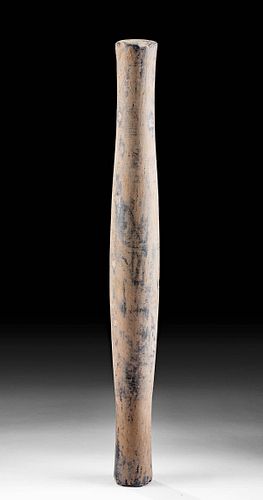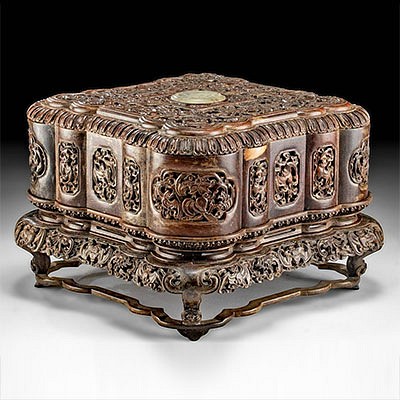Fine Ancient Bactrian Stone Idol / Ritual Object
Lot 35
About Seller
Artemis Gallery
686 S Taylor Ave, Ste 106
Louisville, CO 80027
United States
Selling antiquities, ancient and ethnographic art online since 1993, Artemis Gallery specializes in Classical Antiquities (Egyptian, Greek, Roman, Near Eastern), Asian, Pre-Columbian, African / Tribal / Oceanographic art. Our extensive inventory includes pottery, stone, metal, wood, glass and textil...Read more
Categories
Estimate:
$3,000 - $4,500
Absentee vs Live bid
Two ways to bid:
- Leave a max absentee bid and the platform will bid on your behalf up to your maximum bid during the live auction.
- Bid live during the auction and your bids will be submitted real-time to the auctioneer.
Bid Increments
| Price | Bid Increment |
|---|---|
| $0 | $25 |
| $300 | $50 |
| $1,000 | $100 |
| $2,000 | $250 |
| $5,000 | $500 |
| $10,000 | $1,000 |
| $20,000 | $2,500 |
| $50,000 | $5,000 |
| $100,000 | $10,000 |
| $200,000 | $20,000 |
About Auction
By Artemis Gallery
Apr 8, 2021
Set Reminder
2021-04-08 10:00:00
2021-04-08 10:00:00
America/New_York
Bidsquare
Bidsquare : Fine Antiquities | Asian | Ethnographic Art
https://www.bidsquare.com/auctions/artemis-gallery/fine-antiquities-asian-ethnographic-art-6770
Features classical antiquities, ancient and ethnographic art from cultures encompassing the globe. Egyptian, Greek, Roman, Etruscan, Near Eastern, Asian, Pre-Columbian, Native American, African / Tribal, Oceanic, Spanish Colonial, Russian, Fine Art, so much more! All legally acquired, legal to sell. Artemis Gallery info@artemisgallery.com
Features classical antiquities, ancient and ethnographic art from cultures encompassing the globe. Egyptian, Greek, Roman, Etruscan, Near Eastern, Asian, Pre-Columbian, Native American, African / Tribal, Oceanic, Spanish Colonial, Russian, Fine Art, so much more! All legally acquired, legal to sell. Artemis Gallery info@artemisgallery.com
- Lot Description
Central Asia, modern day Pakistan / Afghanistan, Bactria, late 2nd to early 1st millennium BCE. A fine stone idol or ritual object hand-carved in a columnar form. This intriguing object features a lengthy, cylindrical body with a thick midsection that narrows at each end to a flared, circular base and top. Boasting a lovely hue of light grey accented with tan-colored earthen deposits, stone idols like this one are known in a variety of forms; however, their true meaning is unknown because there are no surviving written records that explicate how they were used. Were they used as objects of worship, commerce, torture, or everyday use? Whatever the case, this is a wonderful example from early Bactria! Size: 2.75" in diameter x 23.75" H (7 cm x 60.3 cm)
Ancient idols like this one, that reduce natural forms to a simple collection of shapes and lines, are considered some of our oldest abstract art. They fascinate us today in part because they hint at a belief system and cosmology that we can no longer access or understand. Instead, we guess at the meaning. Are they fertility charms? Representations of old gods? Were they made to be carried as apotropaic charms, or simply to be placed in tombs? Their mute sculptures raise more questions than they answer.
Provenance: ex-Phoenicia Holyland Antiquities, New York City, New York, USA, acquired before 2010
All items legal to buy/sell under U.S. Statute covering cultural patrimony Code 2600, CHAPTER 14, and are guaranteed to be as described or your money back.
A Certificate of Authenticity will accompany all winning bids.
We ship worldwide and handle all shipping in-house for your convenience.
#162816Recessed circle on one end, possibly from construction. Expected nicks and chips to rims and body, as well as scratches and abrasions, all commensurate with age. Otherwise, very nice with rich earthen deposits throughout.Condition
- Shipping Info
-
All shipping is handled in-house for your convenience. Your invoice from Artemis Gallery will include shipping calculation instructions. If in doubt, please inquire BEFORE bidding for estimated shipping costs for individual items.
-
- Buyer's Premium



 EUR
EUR CAD
CAD AUD
AUD GBP
GBP MXN
MXN HKD
HKD CNY
CNY MYR
MYR SEK
SEK SGD
SGD CHF
CHF THB
THB













